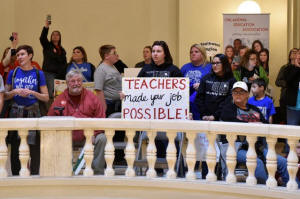|
Sagging school funding fuels U.S. teacher
protests
 Send a link to a friend
Send a link to a friend
 [April 05, 2018]
By Karen Pierog [April 05, 2018]
By Karen Pierog
CHICAGO (Reuters) - U.S. teacher
demonstrations are likely to spread as more educators hit the streets to
take on states that they claim are choosing tax cuts over the education
of students in elementary and secondary public schools.
Protests have erupted in states with some of the lowest teacher salaries
in the nation, leading to multi-day job actions in a few states.
For a graphic showing teacher salaries, click:
(https://tmsnrt.rs/2IsvlGa)
Educator unrest began in West Virginia, where teachers ended a nine-day
strike last month after the state approved a 5 percent pay hike.
This week, massive teacher protests closed schools in Oklahoma.
American Federation of Teachers President Randi Weingarten said the
demonstrations, which have so far taken place in right-to-work states
with weak labor laws, underscore how fed up teachers have become over
the deprivation caused by inadequate funding due to tax cuts.
"I do think this will happen more and more because the era of passive
resignation seems to be over. And that's only good news for the children
that we serve and the educators we represent," Weingarten told Reuters.

Oklahoma has the lowest median pay among states for both elementary and
secondary school teachers, according to 2017 data from the U.S. Bureau
of Labor Statistics. The state's budget has been hit by a combination of
tax cuts and a slump in energy prices, a significant source of tax
revenue.
Weingarten said teachers there are struggling with stagnant pay,
decades-old textbooks and big class sizes.
ARIZONA HEAT
Meanwhile, teacher unrest is growing in Arizona.
Median teacher salaries in the Grand Canyon state are among the lowest
in the nation, leading to a retention problem. A report last year by the
Morrison Institute for Public Policy at Arizona State University found
that almost a quarter of teachers hired between 2013 and 2015 were no
longer teaching after a year, while 42 percent of teachers hired in 2013
lasted no more than three years.
Dan Hunting, a senior policy analyst at the institute, said taxes in
Arizona as a percentage of the economy have been reduced by about a
third since the early 1990s, resulting in less state money for schools.
"It's going to take a while for us to get out of this. There's not going
to be a magic bullet," Hunting said.
[to top of second column]
|

Teachers rally inside of the state Capitol rotunda on the second day
of a teacher walkout to demand higher pay and more funding for
education in Oklahoma City, Oklahoma, U.S., April 3, 2018.
REUTERS/Nick Oxford

The common thread in all three states is tax cuts that were
undertaken in the years before and after the Great Recession,
according to Michael Leachman, director of state fiscal research at
the Center on Budget and Policy Priorities. The group describes
itself as a nonpartisan research institute.
"Teacher compensation is the biggest part of school budgets," he
said. "If you cut the revenue that's available to spend on schools
it makes it hard to pay for qualified teachers."
On a national basis, 47 percent of funding for public schools comes
from states, with 45 percent raised locally and 8 percent coming
from the federal government, Leachman said. In more than half of the
states, per-pupil funding from state and local sources from 2008
through 2015 was below 2008 levels.
For a graphic showing the change in per pupil education funding,
click: (https://tmsnrt.rs/2Iumbck)
Leachman said problems could be brewing in the low-teacher pay
states of North Carolina and Mississippi.
For example, North Carolina is projecting budget shortfalls topping
$1 billion starting in fiscal 2020 as income tax cuts are phased in,
according to a July five-year forecast.
When state funding falls, some mostly poorer school districts are
unable to make up the difference, leading to inequities among
districts.
Funding inequities have fueled lawsuits in 46 states over the last
45 years, according to Michael Rebell, who heads the Center for
Educational Equity at Columbia University's Teachers College, which
tracks school funding litigation. He said districts and other
plaintiffs that have sued states have prevailed 60 percent of the
time.
To remedy those cases, states tend to hold rich districts harmless
and give poor districts a bigger funding increase, he said.
(Reporting by Karen Pierog in Chicago; Editing by Daniel Bases and
Matthew Lewis)
[© 2018 Thomson Reuters. All rights
reserved.]
Copyright 2018 Reuters. All rights reserved. This material may not be published,
broadcast, rewritten or redistributed.
Thompson Reuters is solely responsible for this content. |